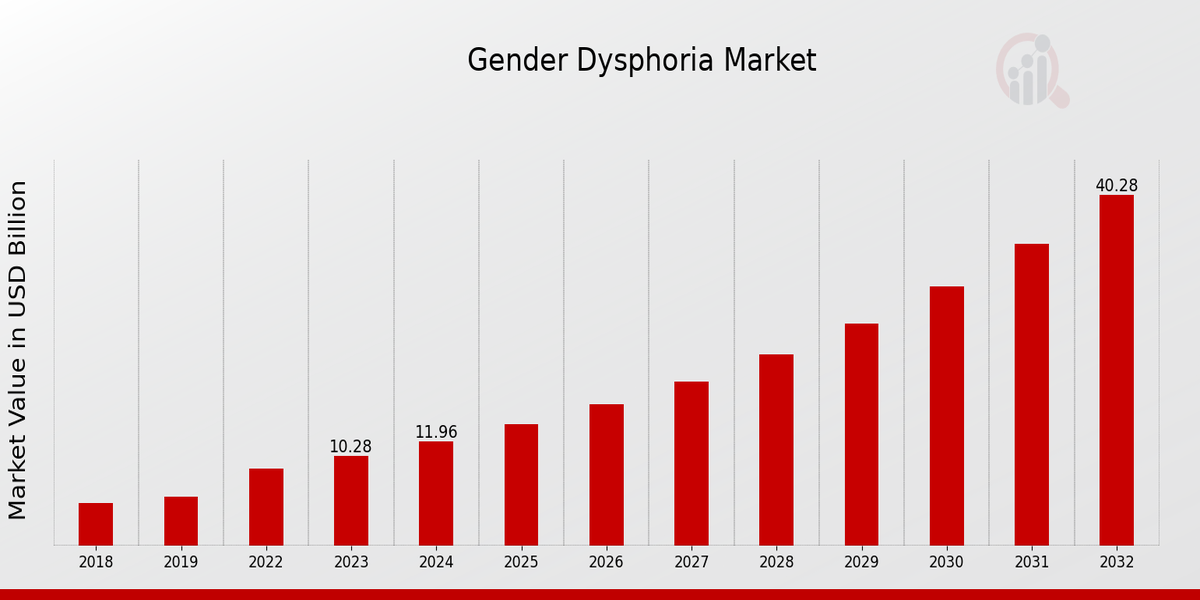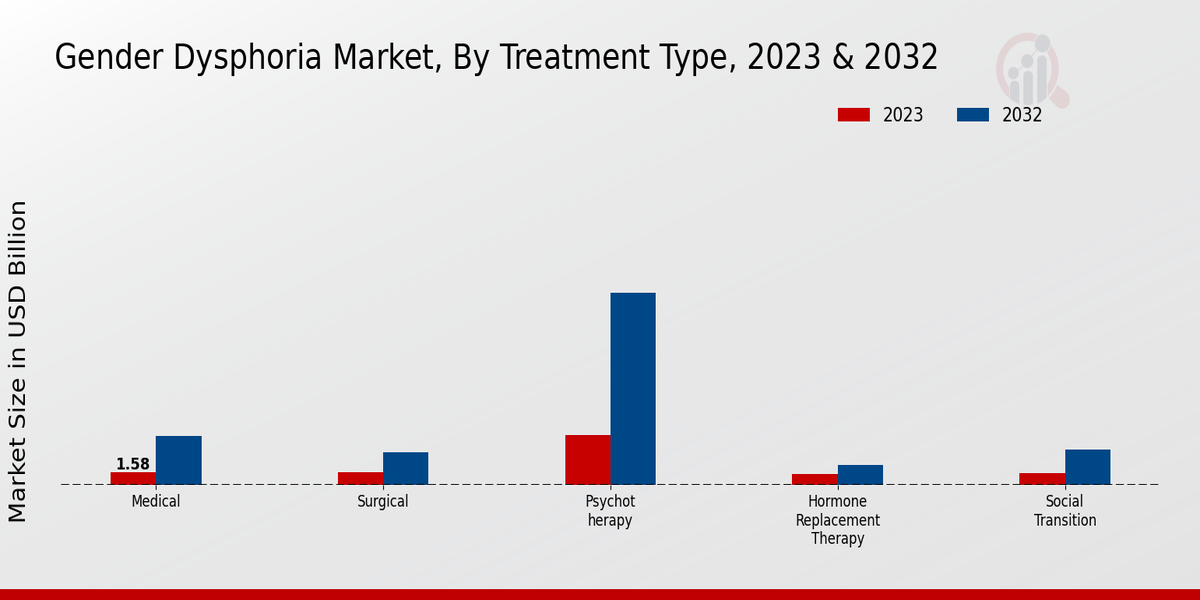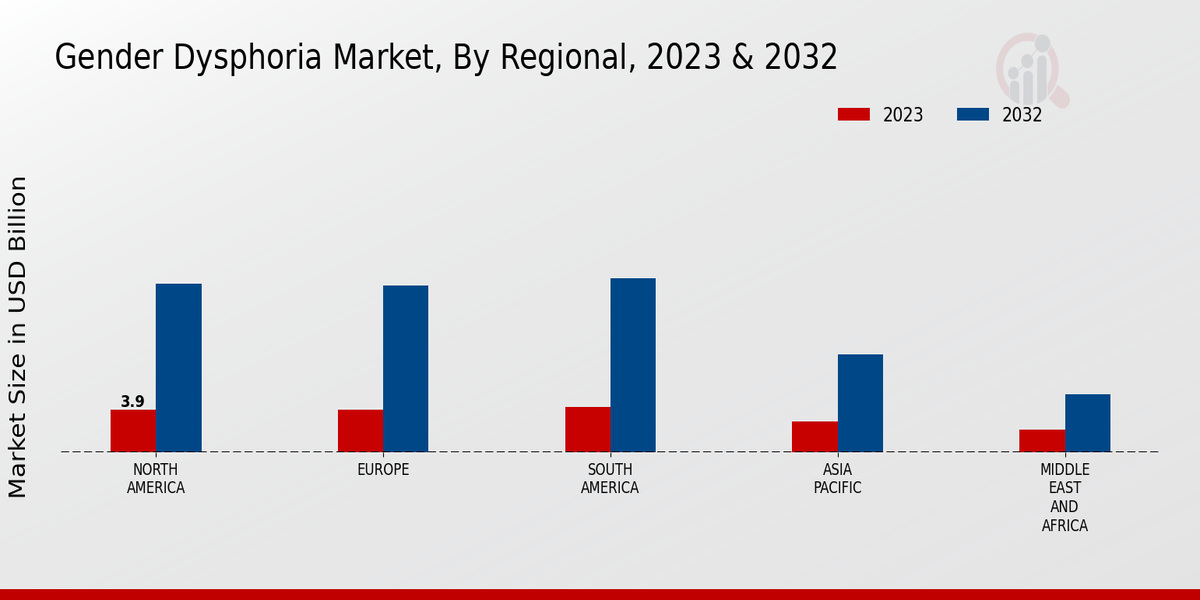Gender Dysphoria Market Overview
As per MRFR analysis, the Gender Dysphoria Market Size was estimated at 8.83 (USD Billion) in 2022. The Gender Dysphoria Market Industry is expected to grow from 10.28(USD Billion) in 2023 to 40.3 (USD Billion) by 2032. The Gender Dysphoria Market CAGR (growth rate) is expected to be around 16.39% during the forecast period (2024 - 2032).
Key Gender Dysphoria Market Trends Highlighted
The key factors contributing to the growth of the gender dysphoria market include acceptance for transgender people and other gender-diverse individuals, increasing knowledge about gender dysphoria and ways to treat it, and the increasing number of healthcare services accessible to transgender persons. More effective methods of treating this condition, widening the scope of insurance for gender affirmative care, and setting up more focused centers and communities for transgender people are areas ready for penetration.
The trends presently observed in the treatment of the gender dysphoria market include a rise in the adoption of hormone therapy and gender affirming surgeries, introduction of new minimally invasive surgical procedures, and an increase in the focus on global transgender healthcare. These trends are bound to continue in the coming years as the gender dysphoria treatment market develops and grows.

Source: Primary Research, Secondary Research, MRFR Database and Analyst Review
Gender Dysphoria Market Drivers
Rising Prevalence of Gender Dysphoria
Gender dysphoria is a condition that describes the unease a person may experience due to a discrepancy between their birth sex and gender identity. The increasing prevalence of gender dysphoria is one of the key forces fueling the growth of the Gender Dysphoria Market. A study published in 2021 in the journal The Lancet estimated that the prevalence of gender dysphoria among adults in the United States was around 0.5%, which was significantly higher than the prevalence reported in previous research.As more individuals suffer from this disorder, there is a high probability that the increased demand for gender dysphoria treatments and services will drive growth in the Gender Dysphoria Market. Other forces that are contributing to the growth of the Gender Dysphoria Market include: Increasing acceptance of LGBTQ+ individuals at the societal level Greater availability of gender-affirming care Increasing number of individuals seeking gender-affirming surgeries and procedures Growing societal awareness about the benefits of gender-affirming care Research and development investments in new gender-affirming products and procedures.
Technological Advancements in Gender-Affirming Care
The field of gender-affirming care is constantly evolving, with new and innovative treatments and procedures being developed all the time. These advancements are making it easier for transgender and non-binary individuals to achieve their desired gender expression and alleviate the symptoms of gender dysphoria. Some of the most recent technological advancements in gender-affirming care include: Minimally invasive gender-affirming surgeries: These surgeries are less invasive than traditional gender-affirming surgeries, and they result in less scarring and a faster recovery time. Non-hormonal gender-affirming treatments: These treatments do not involve the use of hormones, and they can be used to alleviate the symptoms of gender dysphoria without the need for surgery. Telehealth for gender-affirming care: Telehealth is making it easier for transgender and non-binary individuals to access gender-affirming care, regardless of their location. Telehealth providers can offer a variety of services, including consultations, hormone therapy, and support groups. These technological advancements are making gender-affirming care more accessible and affordable for transgender and non-binary individuals. As a result, the demand for gender-affirming care is expected to continue to grow in the coming years.
Growing Demand for Gender-Affirming Surgeries and Procedures
Gender-confirming surgeries and procedures play an important role in the life of many transgender and non-binary people who wish to bring their outer appearance in line with their gender identity and relieve the symptoms of gender dysphoria. In addition, the demand for these surgeries and procedures has been rapidly increasing since more transgender and non-binary people come out and seek proper treatment for their gender identity. Some of the most common gender-confirmation surgeries and procedures include: Chest masculinization surgery, which is performed on transgender male people to provide them with a more male chest; Chest feminization surgery, which is performed on transgender female people to provide them with a more female chest; Phalloplasty, which is a surgery performed on transgender male people to install a penis; Metoidioplasty, which is performed on transgender female people to install clitoris and labia; Hysterectomy, which is performed on transgender male people to remove the uterus and ovaries; Oophorectomy, which is performed on transgender female people to remove the ovaries.The demand for gender-confirming surgeries and procedures will continue to rise in the next few years as more transgender and non-binary people plant to seek proper healthcare. The surge in growth will be caused by multiple factors, such as the increased acceptance of transgender and non-binary individuals, higher access to gender-confirming surgeries and procedures, and a visible increase in awareness of their benefits in the target group.
Gender Dysphoria Market Segment Insights
Gender Dysphoria Market Treatment Type Insights
The Gender Dysphoria Market is segmented by Treatment Type into Medical, Surgical, Psychotherapy, Hormone Replacement Therapy, and Social Transition. Among these, the medical segment held the largest market share in 2023, and it is projected to continue its dominance throughout the forecast period. The growth of this segment can be attributed to the increasing demand for non-invasive and reversible treatments for gender dysphoria. Surgical treatments, which involve procedures such as vaginoplasty, phalloplasty, and metoidioplasty, are also expected to witness significant growth in the coming years.
The rising number of individuals seeking surgical interventions to align their physical appearance with their gender identity is driving the demand for these procedures. Psychotherapy, which involves providing psychological support and counseling to individuals with gender dysphoria, is another key segment in the market. The growing awareness about the mental health challenges faced by transgender individuals is fueling the demand for psychotherapy services. Hormone Replacement Therapy (HRT), which involves the administration of hormones to induce physical changes consistent with the desired gender identity, is also expected to contribute to the growth of the Gender Dysphoria Market.HRT is commonly used to alleviate gender dysphoria and improve the overall well-being of transgender individuals. Social Transition, which involves changing one's name, pronouns, and social roles to align with their gender identity, is an important aspect of gender dysphoria treatment. The increasing acceptance of transgender individuals in society is creating a more supportive environment for social transition, which is expected to drive the growth of this segment in the coming years. Overall, the Gender Dysphoria Market is expected to witness substantial growth in the coming years, driven by the increasing prevalence of gender dysphoria, growing awareness about treatment options, and supportive government policies.

Source: Primary Research, Secondary Research, MRFR Database and Analyst Review
Gender Dysphoria Market Age Group Insights
The Gender Dysphoria Market is categorized by Age Group into Children and Adolescents, Adults, and Older Adults. Out of these categories, the segment of Adults held the largest market share of the Gender Dysphoria Market revenue in 2023, which constituted over 60% of the total market. The reason for such a large market share for this and the remaining segments is that adults have the highest share of prevalence of gender dysphoria diseases, and that people have acquired increased understanding and acceptance of healthcare therapies tailored to meet their gender preferences.The segment of Children and Adolescents has the highest future growth probability, due to the increasing awareness of gender dysphoria diseases among this age group of people, and since adequate healthcare support services are becoming more available to them. The segment of Older Adults has the smallest probable market share due to the least expected amount of prevalence of the disease in them, and because the number of healthcare products and services available to them is the least.
Gender Dysphoria Market Gender Identity Insights
The Gender Dysphoria Market segmentation by Gender Identity encompasses individuals who identify as Transgender, Non-Binary, Agender, and Gender Fluid. In 2023, the Transgender segment held the largest market share due to the rising prevalence of gender dysphoria among transgender individuals. The Non-Binary segment is projected to witness significant growth over the forecast period owing to increasing awareness and acceptance of non-binary identities. Agender and Gender Fluid individuals also contribute to the market growth, driven by factors such as self-identification and access to gender-affirming care.The Gender Dysphoria Market data indicates that the Gender Identity segment is poised to grow at a robust CAGR during the forecast period, fueled by increased visibility, advocacy, and support for gender diverse individuals.
Gender Dysphoria Market Care Setting Insights
The Gender Dysphoria Market is segmented based on Care Setting into Hospitals and Clinics, Private Practices, Community Health Centers, and Online Platforms. Among these, Hospitals and Clinics held the largest market share of around 40% in 2023 and are expected to maintain their dominance throughout the forecast period. This is primarily due to the presence of advanced medical facilities, experienced healthcare professionals, and a wide range of treatment options available in hospitals and clinics. Private Practices accounted for a significant share of the Gender Dysphoria Market revenue in 2023, owing to the increasing number of specialized gender dysphoria clinics and the growing preference for personalized care.Community Health Centers are also gaining traction as they provide accessible and affordable care to underserved communities. Online Platforms, though a relatively new segment, are expected to witness substantial growth in the coming years. The convenience, affordability, and anonymity offered by online platforms are driving their adoption, particularly among individuals who face barriers to accessing traditional care settings.
Gender Dysphoria Market Regional Insights
The regional segmentation of the Gender Dysphoria Market offers insightful data on the market's geographical distribution and growth patterns. North America held the dominant market share in 2023, accounting for approximately 38.2% of the global revenue. The region's well-established healthcare infrastructure, high awareness about gender dysphoria, and supportive government policies contribute to its leading position. Europe is another significant market, projected to witness steady growth over the forecast period. The presence of major pharmaceutical companies and research institutions in the region drives market expansion.APAC is anticipated to emerge as a promising market, driven by rising healthcare expenditure and increasing awareness about gender dysphoria. South America and MEA are expected to contribute a smaller share to the global market but are likely to experience considerable growth in the coming years. These regions present opportunities for market expansion due to growing healthcare investments and increasing disposable income. Overall, the Gender Dysphoria Market exhibits a diverse regional landscape, with each region offering unique growth prospects.

Source: Primary Research, Secondary Research, MRFR Database and Analyst Review
Gender Dysphoria Market Key Players and Competitive Insights
Major players in Gender Dysphoria Market industry are constantly striving to innovate and develop new products to meet the evolving needs of patients. Leading Gender Dysphoria Market players are investing heavily in research and development to bring new therapies and treatments to the market. This competitive landscape is expected to drive Gender Dysphoria Market development and growth in the coming years.AbbVie, a leading player in the Gender Dysphoria Market, has a strong portfolio of products and services that cater to the needs of transgender individuals. The company's commitment to innovation is evident in its pipeline of new and emerging therapies. AbbVie is also actively involved in supporting patient advocacy groups and raising awareness about gender dysphoria.Pfizer, another major player in the Gender Dysphoria Market, offers a comprehensive suite of products and services for transgender patients. The company's focus on research and development has led to the development of innovative therapies that address the unique needs of this population. Pfizer is also committed to providing support and resources to transgender individuals and their families.
Key Companies in the Gender Dysphoria Market Include
- Harvard Medical School
- Mount Sinai Hospital
- Stanford University School of Medicine
- New York University Langone Medical Center
- Johns Hopkins Hospital
- Mayo Clinic
- University of California, San Francisco Medical Center
- University of Pennsylvania Health System
- University of Chicago Medicine
- University of Michigan Health System
- Northwestern Medicine
- Boston IVF
Gender Dysphoria Market Industry Developments
The Gender Dysphoria Market is anticipated to reach a valuation of USD 40.3 billion by 2032, expanding to a CAGR of 16.39% from 2023 to 2032. The rising prevalence of gender dysphoria, increasing awareness about gender-affirming treatments, and growing acceptance of transgender individuals are the key growth drivers for the market. Recent news developments include the approval of new gender-affirming therapies, such as puberty blockers and hormone replacement therapy, by regulatory bodies in various countries, which is expected to boost market growth. Additionally, the increasing number of specialized gender dysphoria clinics and healthcare providers offering gender-affirming care is further contributing to market expansion.
Gender Dysphoria Market Segmentation Insights
Gender Dysphoria Market Treatment Type Outlook
- Medical
- Surgical
- Psychotherapy
- Hormone Replacement Therapy
- Social Transition
Gender Dysphoria Market Age Group Outlook
- Children and Adolescents (Under 18 years)
- Adults (18-64 years)
- Older Adults (65 years and above)
Gender Dysphoria Market Gender Identity Outlook
- Transgender
- Non-Binary
- Agender
- Gender Fluid
Gender Dysphoria Market Care Setting Outlook
- Hospitals and Clinics
- Private Practices
- Community Health Centers
- Online Platforms
Gender Dysphoria Market Regional Outlook
- North America
- Europe
- South America
- Asia Pacific
- Middle East and Africa
| Report Attribute/Metric |
Details |
| Market Size 2022 |
8.83(USD Billion) |
| Market Size 2023 |
10.28(USD Billion) |
| Market Size 2032 |
40.3(USD Billion) |
| Compound Annual Growth Rate (CAGR) |
16.39% (2024 - 2032) |
| Report Coverage |
Revenue Forecast, Competitive Landscape, Growth Factors, and Trends |
| Base Year |
2023 |
| Market Forecast Period |
2024 - 2032 |
| Historical Data |
2019 - 2023 |
| Market Forecast Units |
USD Billion |
| Key Companies Profiled |
Harvard Medical School, Mount Sinai Hospital, Stanford University School of Medicine, New York University Langone Medical Center, Johns Hopkins Hospital, Mayo Clinic, University of California, San Francisco Medical Center, University of Pennsylvania Health System, University of Chicago Medicine, University of Michigan Health System, Northwestern Medicine, Boston IVF |
| Segments Covered |
Treatment Type, Age Group, Gender Identity, Care Setting, Regional |
| Key Market Opportunities |
· Increasing demand for gender related surgeries · Growing acceptance of gender diversity · Technological advancements in hormone therapies · Rising prevalence of mental health issues related to gender dysphoria · Expansion of insurance coverage for gender reassignment procedures |
| Key Market Dynamics |
Rising prevalence of gender dysphoria, Technological advancements in gender affirming surgeries, increasing acceptance of transgender individuals, Legal and policy changes supporting gender dysphoria treatment, Growing demand for mental health services for transgender individuals |
| Countries Covered |
North America, Europe, APAC, South America, MEA |
Frequently Asked Questions (FAQ) :
The Gender Dysphoria Market size is valued at USD 10.28 billion in 2023.
The Gender Dysphoria Market is expected to reach USD 40.3 billion by 2032, exhibiting a CAGR of 16.39% during the forecast period (2024-2032).
North America is expected to dominate the Gender Dysphoria Market, accounting for a significant share due to the presence of well-established healthcare infrastructure and increasing awareness about gender dysphoria.
Major applications of Gender Dysphoria treatment include hormone replacement therapy, gender-affirming surgeries, psychotherapy, and speech therapy.
Key competitors in the Gender Dysphoria Market include AbbVie Inc., Merck & Co., Inc., Pfizer Inc., Eli Lilly and Company, and Novartis AG.
Rising prevalence of gender dysphoria, increasing awareness about gender-affirming care, and growing acceptance of transgender individuals are driving the growth of the Gender Dysphoria Market.
Challenges faced by the Gender Dysphoria Market include limited access to gender-affirming care, lack of trained healthcare professionals, and stigma associated with gender dysphoria.
Opportunities for growth in the Gender Dysphoria Market lie in the development of new and innovative treatments, expansion of insurance coverage for gender-affirming care, and increased public awareness about gender dysphoria.
Key trends in the Gender Dysphoria Market include the growing use of telemedicine for gender-affirming care, increasing demand for non-surgical gender-affirming procedures, and the emergence of personalized treatment plans.
The Gender Dysphoria Market is expected to have a positive impact on society by improving the quality of life for transgender individuals and reducing the stigma associated with gender dysphoria.















